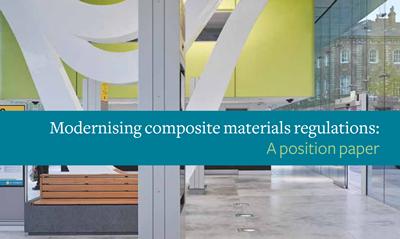New regulations for composite materials worth billions of pounds to UK industry

A new report published by the University of Southampton calls for industry and government to work closely together to put an end to the constraints that currently inhibit the growth and use of composite materials in Marine, Rail, Oil & Gas, and Construction.
According to the position paper ‘Modernising composite materials regulations’, the introduction of effective regulation in the use of composites in these, and other new sectors, could bring more than £4bn worth of benefit to the UK by the year 2030.
The study was carried out by a multidisciplinary team from Southampton’s Faculties of Engineering and the Environment, and Business, Law and Art (Institute of Maritime Law), supported by the Southampton Marine and Maritime Institute and the University’s department for Research and Innovation Services (RIS).
The position paper recognises the UK as a global leader in the research and development of composite materials and structures but points out that the country is not the most agile in bringing these new products to market. As economic and sustainability pressures have grown, so too has pressure increased to reduce energy consumption (including fuel usage) whilst improving both ‘through-life costs’ and installation times. All of these factors have increased demand for stronger, lighter, more intelligent and more durable materials tailor made for purpose.
In 2013, the global market for composite products was US$68bn, which is predicted to grow to US$ 105bn by 2030 (UK Composites Market Study). The UK’s share of this market is £2bn (around 3%) which is estimated to grow to £12bn or more by 2030 (2016 UK Composites Strategy). This figure could rise to as high as £16bn if the sectors that have not previously embraced the use of composites were to experience the same rate of growth as the aerospace sector, where the use of composite materials has increased massively over the last three decades. More than 50% of the weight of the newest generation of aeroplanes is made up by composite materials replacing metal alloys.
One of the major inhibitors to the uptake of composites in new sectors is that regulations, codes and standards are often inappropriate for composites. This is because they are both explicitly and implicitly based on named materials, such as steel, and do not permit consideration of composites applications despite the strengths and benefits of the materials in many cases.
“Advanced polymer composite materials have a huge potential to shape the modern world,” said Professor Ole Thybo Thomsen, a world leading expert on composite structures who is Head of the Infrastructure Research Group at Southampton and co-author of the position paper. “The use of composites in aerospace and automobile design is now the norm, but they have much broader potential for use in other sectors such as in building and bridge construction, railway and rail infrastructure, as well as marine and offshore. In aerospace alone, 52% by weight of the latest generation of aircraft are now composed of composite materials.
“In the UK there is currently very limited coordination and centralisation of the codes and standards data associated with new composite materials,” said Professor Simon Quinn, Director of the University’s Research Institute for Industry (RiFi) and the lead researcher of the paper. “There is neither a coherent development of certified testing facilities, nor a formal process for different sectors to share information and best practice. These factors have reduced productivity, discouraged research and development and innovation, and significantly increased the time to market for new composite products.
Simon continues, “Industry and government have not shared information. In the UK there are four government departments dealing with material regulation and the minister with overall responsibility for Health and Safety (the Minister for the Disabled) has neither the mandate nor the resources to harmonise this system. There are also seven agencies involved in regulation, alongside a lack of Suitably Qualified and Experienced Personnel (SQEP), creating a labyrinth of assurance without the guarantee of certification at the end. This is a considerable disincentive to those companies wanting to innovate, and a significant barrier to new companies entering the markets.”
The paper recommends that ‘performance’ assessment methods should be adapted to the needs of each sector to make it easier for manufacturers to prove that their materials can perform to the required operational safety and performance standards related to that sector.
Perhaps of equal importance is the paper’s call for one government department to have overall responsibility for regulation, with representation in other departments. The lead department would work closely with the Composites Leadership Forum (CLF) and would oversee material regulatory policy and management of the centre, would have the responsibility to develop codes and standards, and would authorise both UK and nominated overseas test centres.
“This approach will increase the value, utility and sustainability of the UK’s composites research and by speeding up the ‘route to market’, allowing the UK to both achieve and maximise its predicted market share and prevent the more agile manufacturing nations using our research to gain a first-mover competitive advantage,” said Rear Admiral Rob Stevens, the lead author of the paper and Adjunct Professor at the University of Southampton. "The next step is create a task group sponsored by Government and including key players from the regulatory bodies, industry and academia to take the new regulatory proposition forward in industries that are not utilising composite materials to their full potential.”
A downloadable copy of the full report is available here.